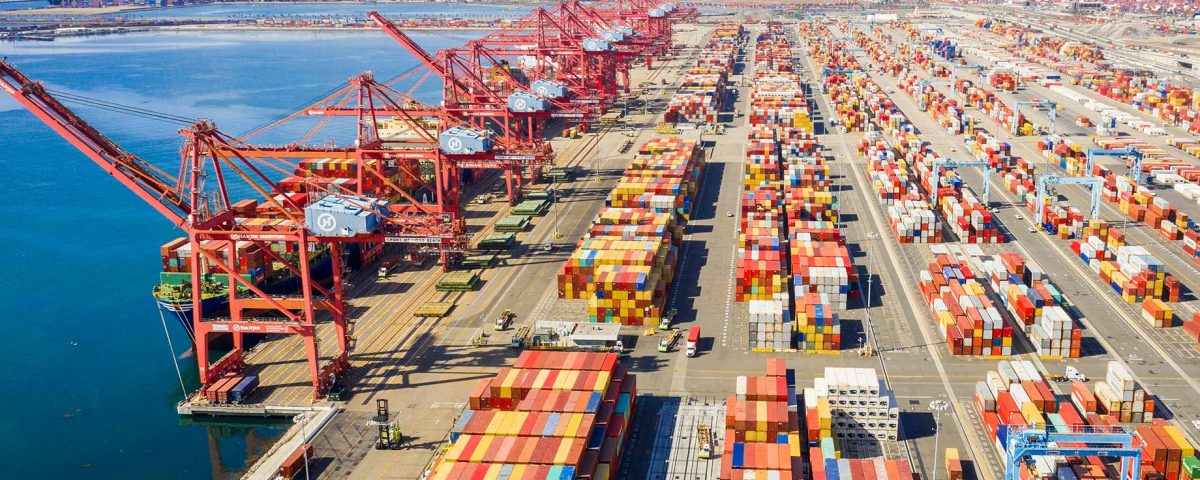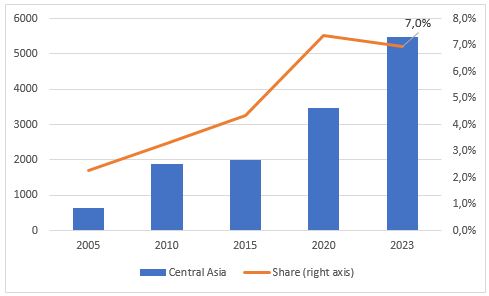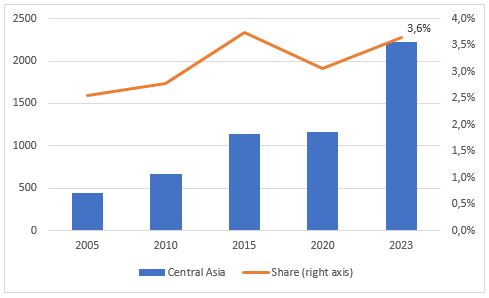In August 2024, Kazakhstan hosted the VI Consultative Meeting of Heads of State of Central Asia (CA) in Astana. During the meeting, the countries of the region signed the Concept for the development of regional cooperation “Central Asia – 2040”. The Concept was developed by Kazakhstan and its priorities include strengthening the international subjectivity of Central Asia (Kapital, 2024). It is worth mentioning that Kazakhstan has been an active supporter and initiator of many regional integration schemes. During the post-Soviet period, the country promoted and supported the Central Asian Economic Cooperation, the Organization of Central Asian Cooperation, and the Central Asian Union. Despite the efforts, no organization of deep integration was established in the region due to the different paths of development of CA countries.
On the contrary, together with Belarus and Russia, Kazakhstan succeeded in launching the Customs Union, which was later transformed into the Eurasian Economic Union. However, currently, CA states show intentions for cooperation and integration. Hence, together with other important documents signed during the VI Consultative Meeting in Astana, the Concept “Central Asia – 2040” is intended to stimulate deeper integration of Central Asia. For the successful practical implementation of the Concept, there is a need to determine priority directions for future cooperation. Taking into consideration economic, political and geographical conditions, the countries of the region should focus on the following areas.
First, the countries of Central Asia should focus on trade and industrial cooperation. Regional trade shows promising results. According to figures 1-2, Kazakhstan’s exports to and imports from CA partners increased. In 2023, the shares of CA countries in Kazakhstan’s total exports reached 7%, while in 2005 this indicator amounted to 2.3%. During the same period, the shares of CA countries in Kazakhstan’s imports increased from 2.5% to 3.6%. Hence, the importance of the CA region as an export market is increasing for Kazakhstan. It is worth mentioning that the authorities of CA need to support measures to increase regional trade in manufacturing and agricultural products. Regional trade in Central Asia should lead to economic diversification of the countries presented and higher production capacity. This can be achieved through the elimination of trade barriers. Regarding industrial cooperation, the authorities need to prepare a list of priority projects, which can be implemented jointly. Priority projects should not include only big businesses. It is important to involve small and medium enterprises in implementing specific projects. Trade and industrial cooperation will stimulate regional investments contributing to the strengthening of CA business ties.
Figure 1. Kazakhstan’s exports to CA countries, million USD
Source: Author’s calculations based on International Trade Center (2024) data.
Figure 2. Kazakhstan’s imports from CA countries, million USD
Source: Author’s calculations based on International Trade Center (2024) data.
Second, countries of the CA region need to strengthen infrastructural cooperation. It is important to mention the current capacities of the Middle Corridor of Kazakhstan and a new ambitious China-Kyrgyzstan-Uzbekistan (CKU) railway. Transit services are expected to become significant revenue sources for Central Asian countries. Moreover, the regional governments plan to penetrate new markets and develop their domestic infrastructure. At the same time, substantial investments are needed to increase the capacity of the Middle Corridor and for the implementation of the CKU railway. Hence, the governments of the region should strengthen investment cooperation to finance these strategic projects. Successful implementation of infrastructural projects with the involvement of CA businesses and their investments will have long-lasting positive effects in decreasing economic and political risks. It is worth mentioning that the Middle Corridor and the CKU railway should not be considered as competing projects, but complementing, and strengthening the positions of CA as an important transit region.
The third priority direction for regional integration are services and digital cooperation. The role of services in Central Asia is increasing and their contribution to the gross domestic products of the regional economies is substantial. Hence, the governments of CA should jointly work on developing high-productive services that can be exported. For instance, Kazakhstan’s President Kassym-Jomart Tokayev calls for cooperation in the fields of education, science, and human capital development. About 9.000 students from the region study in Kazakhstan. The President appreciates the desire of young people from Central Asia to receive higher education in Kazakhstan and invites young people from the region to come to Kazakhstan for educational purposes (Akorda, 2024). At the same time, Central Asia should strengthen digital cooperation. This cooperation can potentially be based on the capacities of the Astana Hub of Kazakhstan, the IT Park of Uzbekistan and the High Technology Park of Kyrgyzstan. Joint efforts of these technology hubs can contribute to the development of highly productive services and, more importantly, the gradual reduction of technological dependence of Central Asia in the long term. To strengthen services and digital cooperation, the governments of Central Asia can unilaterally eliminate restrictions and barriers in the services sector.
Finally, the countries of CA should unite their efforts to address climate change-related risks as the region remains extremely vulnerable. Climate change may cause substantial damage to the economies of CA states, negatively affect agricultural sectors, and deepen water problems. All countries of the region determine climate change as an important issue and start developing adaptation and mitigation policy measures. Kazakhstan adopted the ‘Strategy for Achieving Carbon Neutrality by 2060.’ Uniting efforts in tackling climate change will have positive effects on the region’s energy sector. For instance, as Mikovic (2024) mentions, Azerbaijan, Kazakhstan, and Uzbekistan are establishing a joint venture to export green energy to Europe. It is worth mentioning that the development of renewable energy sources (RES) will have positive macroeconomic effects. Besides exports of green energy, RES development contributes to CA employment by creating green jobs and improving expertise in services. Another positive aspect of climate cooperation is organizing joint research in this field and involving the population and activists in particular in joint events. Increasing public awareness of climate risks and regional efforts will be beneficial in further integration with the support of the population of the region.
The Central Asian region is experiencing substantial transformation driven by regional intentions for integration and external economic and political factors. As Murtazashvili and Umarov (2024) mention, Central Asian nations are showing independent confidence by creatively tackling some of the world’s most complex geopolitical tasks, engaging with Afghanistan, and recognizing the need to develop new partners. Kushkumbayev and Nuriddenova (2024) argue that the bilateral relationships in Central Asia are true drivers of progress in the region and many bilateral treaties are being signed. They distinguish the role of Kazakhstan and Uzbekistan as key drivers of regional integration. According to Aslanov and Akromov (2024), Uzbekistan considers regional integration as an optimal way of mitigating the current economic and political challenges. In fact, joint efforts and regional vision are beneficial for all CA countries to overcome the consequences of existing economic turbulence and geopolitical uncertainty.
In this regard, the Concept “Central Asia – 2040” is a timely and important document that can contribute to the transformation of the regional economies. Trade and industrial cooperation, infrastructural development, digital and green growth can be considered priority areas for Central Asia’s prosperity.
References:
Akorda (2024). The VI Consultative Meeting of the Heads of State of Central Asia was held under the chairmanship of Kassym-Jomart Tokayev. Retrieved from https://www.akorda.kz/ru/pod-predsedatelstvom-kasym-zhomarta-tokaeva-sostoyalas-vi-konsultativnaya-vstrecha-glav-gosudarstv-centralnoy-azii-971327. Accessed on 10.08.2024.
Aslanov, Mirshohid and Otabek, Akromov (2024). At Astana Leaders’ Summit, Uzbekistan’s President highlights ambitions to deepen regional integration. Retrieved from https://thediplomat.com/2024/08/at-astana-leaders-summit-uzbekistans-president-highlights-ambitions-to-deepen-regional-integration/. Accessed on 11.08.2024.
International Trade Center (2024). Trade map. Retrieved from https://www.trademap.org/Index.aspx. Accessed on 14.09.2024.
Kapital (2024). Kazakhstan has developed a development strategy for Central Asia – 2040. Retrieved from https://kapital.kz/economic/125820/kazakhstan-razrabotal-strategiyu-razvitiya-tsentral-naya-aziya-2040.html. Accessed on 25.08.2024.
Kushkumbayev, Sanat and Aizada, Nuriddenova (2024). Can Central Asia deepen multilateral cooperation without institutionalization? Retrieved from https://thediplomat.com/2024/08/can-central-asia-deepen-multilateral-cooperation-without-institutionalization/. Accessed on 14.08.2024.
Mikovic, Nikola (2024). Central Asia’s energy drive spurs regional integration. Retrieved from https://www.lowyinstitute.org/the-interpreter/central-asia-s-energy-drive-spurs-regional-integration. Accessed on 01.09.2024.
Murtazashvili, Jennifer and Temur, Umarov (2024). Nobody’s Backyard: A confident Central Asia. Retrieved from https://carnegieendowment.org/research/2024/09/nobodys-backyard-a-confident-central-asia?lang=en. Accessed on 08.09.2024.
Note: The views expressed in this blog are the author’s own and do not necessarily reflect the Institute’s editorial policy.



